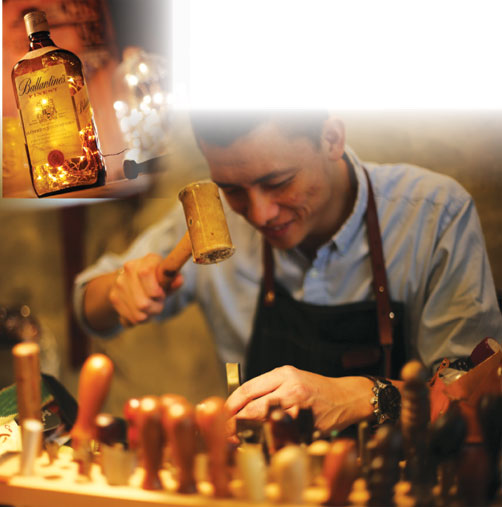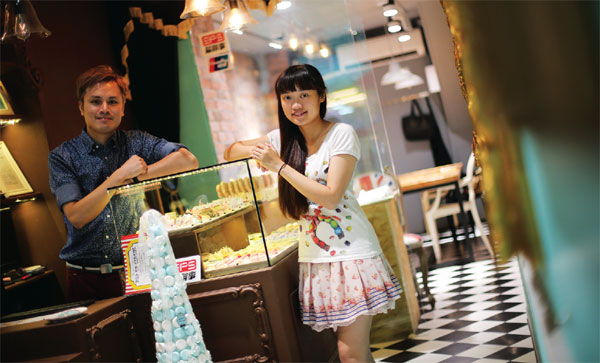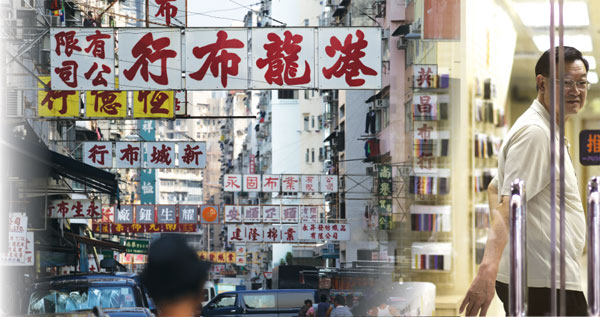Death and rebirth of Sham Shui Po
Updated: 2015-09-16 08:59
By Sylvia Chang(HK Edition)
|
|||||||
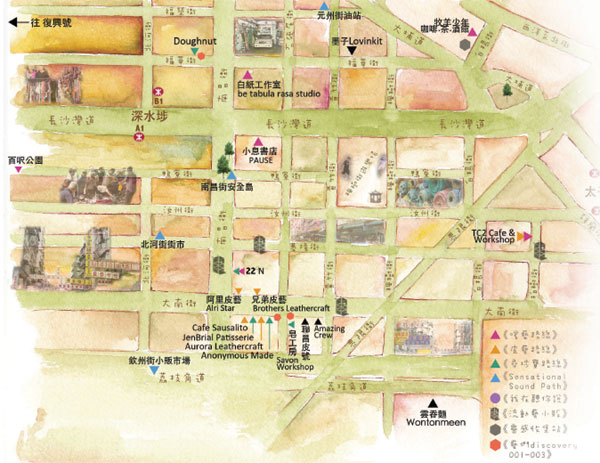
|
Chan Chi-on's enterprise, Brothers Leathercraft, is believed to have inspired others to see the potential of Sham Shui Po and open handicrafts shops in the area. Photos by Edmond Tang, Roy Liu / China Daily |
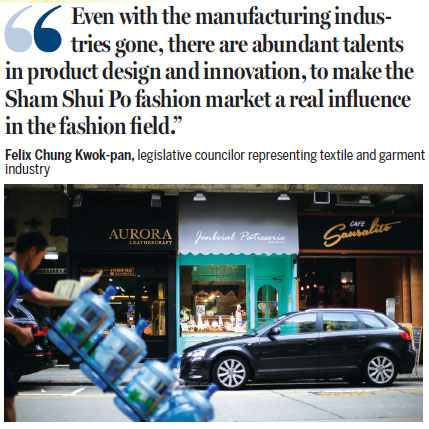
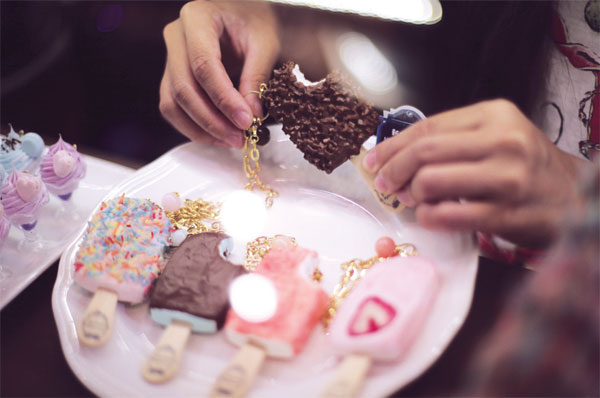
|
Young entrepreneurs like Gabriel Tang and Jenny Yeung have joined the bandwagon, helping to create a new vision for the old streets. |
|
Aged signs proclaiming "clothing for sale" remain on the streets, reminding people of the city's long-gone golden age of textile manufacturing. |
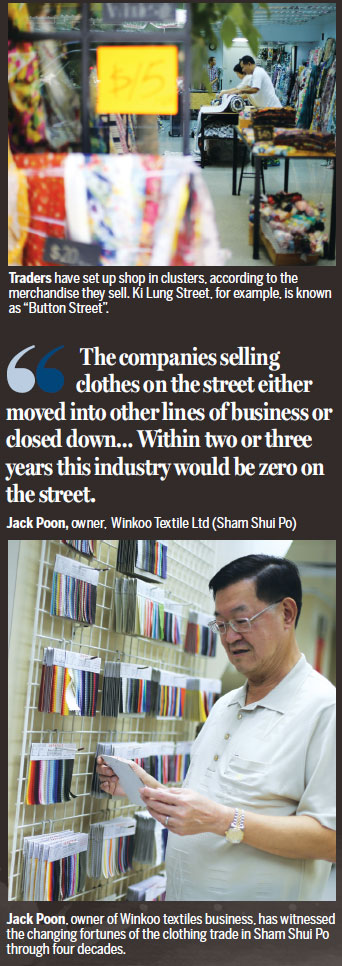
There's a major push to revitalize the once flourishing clothing and accessories district in Sham Shui Po, attracting young entrepreneurs and startup aspirants. Sylvia Chang reports.
There's a new vision taking shape, holding the promise to transform the nearly deserted streets and empty shops of Sham Shui Po into a modern fashion destination with enough appeal to bring tourists to the city's old industrial heartland. Young entrepreneurs catching the scent already are setting up shop in the district.
If final plans are approved, Sham Shui Po is expected to become a showcase for locally designed clothing, self-made handicrafts and distinctive ornamentation, bearing the Hong Kong brand. The place will be lit up, covering the spectrum of glittering colors. Most of all the community hopes that vendor stalls will bustle with local customers and international tourists.
The textile trade, once the livelihood of Sham Shui Po, all but faded away when manufacturing industries pulled up stakes and moved north. The ancient site with its history dating back more than 2,000 years became a relic itself, with the local economy near to destitution. Left behind in the migration of industry across the border to the mainland, was a grey clutter of derelict and decaying buildings.
There remain warrens of shops, selling zippers, buttons, cheap clothing and other gewgaws. Above the walkways, aged signs remain, proclaiming "clothing for sale" in red, Cantonese characters on white metal signboards. There are no customers. Trucks rumble through occasionally, reminding people who have hung on in the district of the city's long-gone golden age of textile manufacturing.
"Apart from publicity and promotion, all elements are set to rebuild Sham Shui Po into a fashion hub, like the Dongdaemun market in South Korea," said Felix Chung Kwok-pan, legislative councilor representing the textile and garment industry.
Signs of hope
Chung proposed the Dongdaemun concept for Sham Shui Po two years ago, calling for a complete makeover of the shambles. A member of the Advisory Group on Implementation of Fashion Initiatives, established on July 13 under the Commerce and Economic Development Bureau, Chung says the proposal, if approved, will allocate a portion of the 500 million dollars provided in the 2015-16 budget, to promote the city's fashion industry.
Even now, before the project's final approval, signs of new growth are springing up. New arrivals to the local business community are giving the area a modicum of glitz and glitter, with the dreary dull streets acquiring what might be called an "arty" appeal.
The fresh faces started moving in about three years ago. That was because property rentals in the city's leading commercial areas of Mong Kok and Causeway Bay went through the roof, and way beyond the means of fledgling shops opened with low capital.
22 Degrees North, a shop and community hub that started up a year ago, is a busy hive of young, far-seeing individuals, who sense the fashion potential of Sham Shui Po. With another 20 young entrepreneurs whose startups feature design and handicrafts, the organizers coordinate "arts tours" of Sham Shui Po, with the intention to spread the word about art and culture in the old neighborhood. Tourists visiting any destinations on the art tour are given commemorative bookmarks, which may be exchanged for artfully-designed postmarks offered by each shop. The idea was adapted from Taiwan's successful tourist promotion strategy.
"These young entrepreneurs are a brand-new social force that is transforming the area into a completely new vision," said Rex Yam, director of 22 Degrees North. With local and international designers, the team organizes exhibitions, music festivals, fashion shows and lectures in an old three-story industrial building that's become the central gathering place. A large, dimly-lit chandelier hangs from the ceiling, reflecting against gray, dark, wooden walls. The atmosphere exudes all the charm of the industrial past. Pop music brings visitors back to the world, where delicate bags and accessories are showcased on wooden shelves.
Chan Chi-on's company, Brothers Leathercraft, is one of the destinations listed on the arts tour. Chan, a 29-year-old artisan who crafts leather handbags, satchels and a range of accessories, began his career by cooperating with an old clothing shop in Sham Shui Po three years ago. "As manufacturing declined, the old shops didn't have as many customers as they had before. So I asked the owner, 'Why not try something new? Maybe it will attract new clients.'"
The shop owner agreed. Chan started selling tools and leathers from the shop. Later, Chan rented a space and set up his own brand in 2013. A year later he opened a second shop, which he believes may have provided the impetus for others to see the area's potential and open handicrafts shops in the area.
Within the last three years, other shops featuring do-it-yourself designs and handicrafts have started springing up. Lawmakers, district councilors and people of different business sectors believe Sham Shui Po can become the platform the city has been seeking to promote local fashion, extending into the international arena.
On Aug 26 Sham Shui Po District Council approved a proposal to revive the clothing market. "Businessmen in this district have been complaining for years about the decaying economy. This decision should rescue the local economy and promote employment among the middle and lower classes in this underprivileged district," says Lee Ying-man, a district councilor of Sham Shui Po and one of the initiators of the proposal.
The support from the district council, says Legislative Congress member Chung, is crucial for the "Dongdaemun model" to be a success here. "The Trade Development Council and the Tourism Board will all help to promote the new fashion market," says Chung. Chung adds that he will team up with Ma Fung-kwok, legislative councilor representing the sports, performing arts, culture and publication sector, to promote cooperative development of both the fashion and film industries.
New vision on old street
Some old industrial buildings in Sham Shui Po will be converted into markets selling handicrafts. A sample room in Kowloon Bay, provided by the Clothing Industry Training Authority, will help young designers learn the technology. The authority will provide training for small-scale production, Chung said.
Shop owners of Sham Shui Po have gathered in clusters, according to the merchandise they sell. Ki Lung Street is known as "Button Street", for example. Nam Cheong Street is "Lace Street", Yu Chau Street is "Bead Street", Tai Nam Street is known as "Leather Street". Cheung Sha Wan Road has been nicknamed "Clothing Road".
The well-devised supply chain that helped Sham Shui Po's former industries to become a model for manufacturing, production and distribution in many other places, is still around. The Hong Kong factories were managed and operated by Hong Kong experts in the field. Chung adds that "even with the manufacturing industries gone, there are abundant talents in product design and innovation, to make the Sham Shui Po fashion market a real influence in the fashion field".
Not far from Chan's shop, Gabriel Tang and Jenny Yeung have joined the trend, helping to create a new vision for the old streets. They run a showroom featuring handmade clay replicas of sweets: cakes, cookies, donuts. The couple offers workshops on making replica sweets with clay. Clay replicas of food items displayed in restaurant windows in Japan are extremely popular. The rest of the world seems to be catching on.
The couple created their brand in 2009 and began selling from a rented space in a shop in Mong Kok. After the rents soared out of reach, they closed up and made a new beginning in Sham Shui Po.
"You can find all materials for handicrafts in Sham Shui Po," said Tang. He added that was an important factor when he and his partner chose their new location. He can buy everything he needs, nearby.
Only two blocks away from 22 Degrees North, a new complex on Lai Chi Kok Road celebrated its grand opening on Aug 29. The building's tenants include new media artists, designers and illustrators, who operate an architectural office, an independent book shop, a DIY coffee shop, and other culture-related entities.
Indeed, people of the younger generation are weaving their dreams in their own space, paying little heed to the pot-boiling policy discussions high up the government ladder. The greatest worry for the youthful owners of startups is that once the renewal work is complete, property values and rentals in Sham Shui Po too will sail out of reach.
Contact the writer at sylvia@chinadailyhk.com
(HK Edition 09/16/2015 page8)
